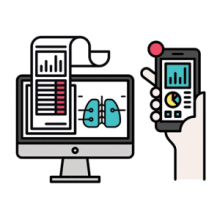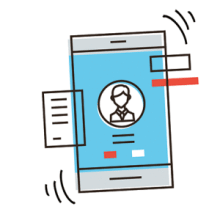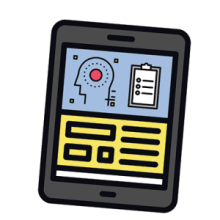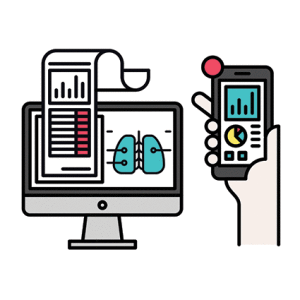User login
As Karen Smith, MD, SFHM, chief of hospital medicine at Children’s National Health System in Washington, D.C., sees it, communication problems often arise at the first possible opportunity, when she’s trying to find out whom to call when she needs to inform a primary care physician or specialist about a hospitalized patient. Sometimes, that information isn’t readily available.
“Which specialist is on and available to talk?” she says.
Then there’s timing.
“By the time we can set up a time to actually talk to people, it’s after normal business hours,” Dr. Smith says. “People aren’t answering their office phones after five. …Your other choice is going through the answering service, but then you get a variety of people and not the person who knows this patient.”
Dr. Smith spearheaded an effort to reach out in a more reliable fashion to community physicians, with a goal of speaking to—or, more commonly, leaving messages with—at least 90% of hospitalized patients’ physicians. They reached the goal, but it was an eye-opening effort.
“The feedback I got from the hospitalists was it’s ‘just so difficult,’” Dr. Smith says. “I’m sitting on the phone waiting to get ahold of someone. Even trying to use administrative people and have them call and contact us, which is kind of complicated to do.”
Yul Ejnes, MD, MACP, a past chair of the board of regents of the American College of Physicians and an internist at Coastal Medical in R.I., says that if he were grading hospitalist communication with primary care providers on a poor-fair-good-excellent scale, he would give it a “fair.”
“It runs the spectrum from getting nothing—which is rare, I have to say—to getting at least a notification that your patient is in the hospital: ‘Here’s a contact number,’ sometimes with diagnosis,” he says. “And, much less commonly, getting a phone call. That usually occurs when there are questions.”
Dr. Ejnes says consistent communication is not as “robust as I would like it to be.”
“Some institutions do much better than others, in terms of the hospitalist always letting us know patients have come in,” he says. “With others, it doesn’t seem to be part of the institutional culture.”
There has to be a better way.
And, in fact, Dr. Smith and many other hospitalists are developing ways to better use technology to communicate more effectively with primary care, specialists, nurses, and patients. The goal is to make communication more routine, more effective, and more convenient for both parties, all the while—hopefully—improving patient care and strengthening working relationships.
Most of the approaches are not ultra-high tech. Too high tech might, in itself, be a potential barrier to communication for those who might be uncomfortable with new technology. Instead, the initiatives are mostly common sense tweaks to—or new, logical uses of—existing technology.
EHR-Embedded Communication
At Children’s National, Dr. Smith and colleagues use a standardized letter as part of a patient’s electronic health record (EHR). In addition to facts about the patient’s condition, the EHR includes information that makes it easier for physicians to communicate.
“What’s lovely with that is that [the letter] tells the provider the team that they’re on,” she said, adding that teams are divided by letter and color. “It has information on how you can reach the doctor. All of our doctors carry a phone around with them, and so it’s got that number.”
The EHR also includes a note suggesting that physicians avoid calling during rounds and gives them information on how to access the portal, so they can follow along with the patient’s care, should they choose to do so.
The amount of actual contact from primary care physicians? Scarce. Maybe one of 20 pediatricians will actually place a call to the hospitalist, but the response she has received has been positive, Dr. Smith says.
The EHR note also includes a sentence further characterizing the patient’s care, such as: Bobby C. was admitted with bronchiolitis. He’s doing fine; I anticipate he will go home tomorrow.
“Pediatricians have loved that,” she says. “They say, ‘I know exactly what my patient’s there for. I had the ability to call if I want.’”
Smarter Pages
At Vanderbilt University Medical Center in Nashville, Tenn., hospitalists noticed a frequent occurrence with pages: Many times, the hospitalist would only receive a phone number.
“With that, you don’t know which patient it’s about, who called you, how urgent it is, or what they need,” says researcher Sunil Kripalani, MD, MSc, SFHM, associate professor and chief of the section of hospital medicine at Vanderbilt.
It’s a tough spot for a busy hospitalist, who might be on the phone or at a bedside with another patient when three, four, or even five pages come through. The page might just be an FYI requiring no callback. It might be urgent. It might be the same page sent multiple times from different numbers (e.g. nursing moving to various phones). Many times, Dr. Kripalani and his hospitalists have had no way to know.
Now, Vanderbilt has established an online template for text pages, with the following basic information:
- Patient;
- Room number;
- Urgency level;
- Name of the sender;
- Callback number;
- Message; and
- Whether or not a callback is needed.
“That structure is very helpful for allowing physicians to triage which pages to call back and how quickly,” Dr. Kripalani says.
He acknowledges it isn’t “fancy bells and whistles.”
“Sometimes it’s doing the basic things well that makes the difference,” he adds.
The “structured pages” have allowed the nature of pages to be analyzed. Dr. Kripalani and colleagues have found that approximately 5% of pages were about a patient’s dietary status. If the patient was ordered not to receive anything by mouth, pages asked, when did that order expire and what diet should the patient resume?
Now, a prompt for that information is included in the hospital’s order entry system, which has cut the number of pages sent.
Vanderbilt is now looking at other, similar ways to streamline communication.
Patients and iPads
At the University of Colorado Hospital in Denver, researchers had an idea to facilitate communication and patient education: Patients are always inquiring about their discharge status and other facets of their hospitalization; what if they got their own tablet to follow along with everything in real time?1
The only real requirements for the study were that patients had to have Internet access at home and an understanding of how to work a web browser, says Jonathan Pell, MD, SFHM, assistant professor of internal medicine at the University of Colorado in Aurora and a hospitalist at University of Colorado Hospital. Patients were shown how to access their schedule for the day, their medication list and dosing schedule, and test results. Much of the information was delivered in real time, so patients who were told that if a lab result came back at a certain level they could be discharged could perhaps start preparing for that possibility earlier than they might have otherwise.
Researchers found that their patients worried less and reported less confusion. They also found that providing the tablets didn’t cause any increase in workload for doctors or nurses.
Providers and nurses expected that patients would notice medication errors, but that endpoint was not significant. Surprisingly, patients’ understanding of discharge times did not live up to expectations. But the results overall were encouraging enough that the effort will continue.
“We have these mixed results,” Dr. Pell says. “I think it’s good to get something out there in the literature and see what else people may be interested in doing. Our next step is to potentially open up notes to patients and let them see their doctor’s and nurse’s notes during their hospitalization.”
He says that, in some cases, communication with patients is the most crucial channel for hospitalists.
“For the very engaged patient [who has] a busy primary care doctor who’s hard to get in touch with,” he explains, “using the patient, informing them well, and getting them all the information they need is actually the best way to make sure that transition of care is smooth.”
Discharge, Facebook-Style
New England Inpatient Specialists (NEIS), a hospitalist group in North Andover, Mass., has an interesting approach to discharge. Instead of a nurse picking up the phone to make a follow-up appointment for a patient leaving the hospital, a secretary posts a message on “Chatter,” a secure tool similar to Facebook. The technology was developed by Salesforce.com, which offers platforms mainly designed to assist businesses with communication.
The idea behind Chatter is that the primary care office personnel can respond to a post at a time that’s convenient to them.
“All of this is so time-consuming. Why would you want somebody like an RN spending 15 to 20 minutes on the phone setting up an appointment when she could be on the floor?” says Sawad Thotathil, MD, vice president of performance and physician recruitment at NEIS. “Our program secretary will just post a discharge, and then somebody at the practice will look at it when they can and find out what associated information is needed and answer at their own convenience.”
Dr. Thotathil’s group also has been using the Imprivata Cortext secure text messaging system for more than a year, with what he deems “overall positive” results. About 60% of the practices with which NEIS staff need to communicate have signed on to the system.
“That kind of helps in management,” he says. “Sometimes, a patient is in the hospital and you can text the cardiologist, asking if the patient can be taken on for a procedure. That kind of communication, which would have taken longer or would not have happened, is happening now.
“Have we been able to directly link it to better outcomes?” he adds. “No, we haven’t looked at it that way. But what we have seen is that there’s always going to be a variation in how many people in a network actually will use it. ... There are going to be those high users, and there are going to be those providers who are going to be minimally using it.”
Videoconferencing
Pediatric hospitalists at the main hospital at Children’s National have been helping to provide care to children who are seen at five community sites. Dr. Smith says the communication at these sites, mostly from the ED, in which the pediatric hospitalists are helping make medical decisions, has been dramatically enhanced.
“The visual aspect of it changes the whole conversation,” she says. “You could tell them the exact same thing verbally and they are like, ‘OK, that’s fine,’ and there doesn’t seem to be a true understanding of what I’m trying to impart to you. Once people look at the child, all of a sudden there is a true shared mental model of, ‘OK, I understand what you’re doing. What’s going on?’”
Hospitalists also have been spearheading videoconferencing at diabetes clinics, to provide better care at community sites.
“We know what the need is. We know the gap in care,” Dr. Smith says. “We’ve been able to advocate and get those specialists brought out to the community via telemedicine, if it’s too difficult to get out on a regular basis.”
There are no hard data on the effects of the programs, but Dr. Smith says the improvement is noticeable.
“Anecdotally, we’ve seen a decrease in kids coming in with DKA (diabetic ketoacidosis) to the emergency room, so we’ve been able to change some of the trajectory. Many of those kids just didn’t have access to care. [For some], it would be a day’s trip for them to get to one of the academic centers to get follow up. They just wouldn’t go.”
EHR-Facilitated Calls
At Cincinnati Children’s, phone contact with community pediatricians at discharge is established with remarkable consistency: 98% to 99% of the time. The reason? A communication system, “Priority Link,” is connected to the EHR.
When the hospitalist signs a discharge order, the patient’s name is put in a queue. An operator sends out a page to inform the resident that the call is about to be made to the outpatient physician, making sure they’re ready for the call to be made.
“The key innovation was that we were trying to make sure that the inpatient side of it was really ready for the call, so we weren’t placing calls out to doctors and then we weren’t ready,” says Jeffrey Simmons, MD, MSc, associate director of clinical operations and quality in Cincinnati Children’s hospital medicine division.
He says there has been some pushback from pediatricians who feel the calls don’t provide any more value than the discharge summary itself. But the opportunity for questions and for a dialogue makes the calls worthwhile, Dr. Simmons notes. The system could be improved by tailoring communications to the community physicians’ preference—via fax or email, perhaps—and by having the call placed by physicians who are more knowledgeable about the details of the case.
Priority Link also is used to help community physicians with direct admissions for patients who don’t need to go to the ED. The operator coordinates a three-way call among the community physician, the hospitalist, and a nurse familiar with the bed situation.
“That three-way call is really great because we’re big and busy enough that sometimes we need that nurse manager on the phone, too, to No. 1, let us know if there really is a bed and, No. 2, coordinate with the nursing unit,” he says. TH
Tom Collins is a freelance writer in South Florida.
Reference
Pell JM, Mancuso M, Limon S, Oman K, Lin CT. Patient access to electronic health records during hospitalization. JAMA Intern Med. 2015;175(5):856-858. doi: 10.1001/jamainternmed.2015.121.
As Karen Smith, MD, SFHM, chief of hospital medicine at Children’s National Health System in Washington, D.C., sees it, communication problems often arise at the first possible opportunity, when she’s trying to find out whom to call when she needs to inform a primary care physician or specialist about a hospitalized patient. Sometimes, that information isn’t readily available.
“Which specialist is on and available to talk?” she says.
Then there’s timing.
“By the time we can set up a time to actually talk to people, it’s after normal business hours,” Dr. Smith says. “People aren’t answering their office phones after five. …Your other choice is going through the answering service, but then you get a variety of people and not the person who knows this patient.”
Dr. Smith spearheaded an effort to reach out in a more reliable fashion to community physicians, with a goal of speaking to—or, more commonly, leaving messages with—at least 90% of hospitalized patients’ physicians. They reached the goal, but it was an eye-opening effort.
“The feedback I got from the hospitalists was it’s ‘just so difficult,’” Dr. Smith says. “I’m sitting on the phone waiting to get ahold of someone. Even trying to use administrative people and have them call and contact us, which is kind of complicated to do.”
Yul Ejnes, MD, MACP, a past chair of the board of regents of the American College of Physicians and an internist at Coastal Medical in R.I., says that if he were grading hospitalist communication with primary care providers on a poor-fair-good-excellent scale, he would give it a “fair.”
“It runs the spectrum from getting nothing—which is rare, I have to say—to getting at least a notification that your patient is in the hospital: ‘Here’s a contact number,’ sometimes with diagnosis,” he says. “And, much less commonly, getting a phone call. That usually occurs when there are questions.”
Dr. Ejnes says consistent communication is not as “robust as I would like it to be.”
“Some institutions do much better than others, in terms of the hospitalist always letting us know patients have come in,” he says. “With others, it doesn’t seem to be part of the institutional culture.”
There has to be a better way.
And, in fact, Dr. Smith and many other hospitalists are developing ways to better use technology to communicate more effectively with primary care, specialists, nurses, and patients. The goal is to make communication more routine, more effective, and more convenient for both parties, all the while—hopefully—improving patient care and strengthening working relationships.
Most of the approaches are not ultra-high tech. Too high tech might, in itself, be a potential barrier to communication for those who might be uncomfortable with new technology. Instead, the initiatives are mostly common sense tweaks to—or new, logical uses of—existing technology.
EHR-Embedded Communication
At Children’s National, Dr. Smith and colleagues use a standardized letter as part of a patient’s electronic health record (EHR). In addition to facts about the patient’s condition, the EHR includes information that makes it easier for physicians to communicate.
“What’s lovely with that is that [the letter] tells the provider the team that they’re on,” she said, adding that teams are divided by letter and color. “It has information on how you can reach the doctor. All of our doctors carry a phone around with them, and so it’s got that number.”
The EHR also includes a note suggesting that physicians avoid calling during rounds and gives them information on how to access the portal, so they can follow along with the patient’s care, should they choose to do so.
The amount of actual contact from primary care physicians? Scarce. Maybe one of 20 pediatricians will actually place a call to the hospitalist, but the response she has received has been positive, Dr. Smith says.
The EHR note also includes a sentence further characterizing the patient’s care, such as: Bobby C. was admitted with bronchiolitis. He’s doing fine; I anticipate he will go home tomorrow.
“Pediatricians have loved that,” she says. “They say, ‘I know exactly what my patient’s there for. I had the ability to call if I want.’”
Smarter Pages
At Vanderbilt University Medical Center in Nashville, Tenn., hospitalists noticed a frequent occurrence with pages: Many times, the hospitalist would only receive a phone number.
“With that, you don’t know which patient it’s about, who called you, how urgent it is, or what they need,” says researcher Sunil Kripalani, MD, MSc, SFHM, associate professor and chief of the section of hospital medicine at Vanderbilt.
It’s a tough spot for a busy hospitalist, who might be on the phone or at a bedside with another patient when three, four, or even five pages come through. The page might just be an FYI requiring no callback. It might be urgent. It might be the same page sent multiple times from different numbers (e.g. nursing moving to various phones). Many times, Dr. Kripalani and his hospitalists have had no way to know.
Now, Vanderbilt has established an online template for text pages, with the following basic information:
- Patient;
- Room number;
- Urgency level;
- Name of the sender;
- Callback number;
- Message; and
- Whether or not a callback is needed.
“That structure is very helpful for allowing physicians to triage which pages to call back and how quickly,” Dr. Kripalani says.
He acknowledges it isn’t “fancy bells and whistles.”
“Sometimes it’s doing the basic things well that makes the difference,” he adds.
The “structured pages” have allowed the nature of pages to be analyzed. Dr. Kripalani and colleagues have found that approximately 5% of pages were about a patient’s dietary status. If the patient was ordered not to receive anything by mouth, pages asked, when did that order expire and what diet should the patient resume?
Now, a prompt for that information is included in the hospital’s order entry system, which has cut the number of pages sent.
Vanderbilt is now looking at other, similar ways to streamline communication.
Patients and iPads
At the University of Colorado Hospital in Denver, researchers had an idea to facilitate communication and patient education: Patients are always inquiring about their discharge status and other facets of their hospitalization; what if they got their own tablet to follow along with everything in real time?1
The only real requirements for the study were that patients had to have Internet access at home and an understanding of how to work a web browser, says Jonathan Pell, MD, SFHM, assistant professor of internal medicine at the University of Colorado in Aurora and a hospitalist at University of Colorado Hospital. Patients were shown how to access their schedule for the day, their medication list and dosing schedule, and test results. Much of the information was delivered in real time, so patients who were told that if a lab result came back at a certain level they could be discharged could perhaps start preparing for that possibility earlier than they might have otherwise.
Researchers found that their patients worried less and reported less confusion. They also found that providing the tablets didn’t cause any increase in workload for doctors or nurses.
Providers and nurses expected that patients would notice medication errors, but that endpoint was not significant. Surprisingly, patients’ understanding of discharge times did not live up to expectations. But the results overall were encouraging enough that the effort will continue.
“We have these mixed results,” Dr. Pell says. “I think it’s good to get something out there in the literature and see what else people may be interested in doing. Our next step is to potentially open up notes to patients and let them see their doctor’s and nurse’s notes during their hospitalization.”
He says that, in some cases, communication with patients is the most crucial channel for hospitalists.
“For the very engaged patient [who has] a busy primary care doctor who’s hard to get in touch with,” he explains, “using the patient, informing them well, and getting them all the information they need is actually the best way to make sure that transition of care is smooth.”
Discharge, Facebook-Style
New England Inpatient Specialists (NEIS), a hospitalist group in North Andover, Mass., has an interesting approach to discharge. Instead of a nurse picking up the phone to make a follow-up appointment for a patient leaving the hospital, a secretary posts a message on “Chatter,” a secure tool similar to Facebook. The technology was developed by Salesforce.com, which offers platforms mainly designed to assist businesses with communication.
The idea behind Chatter is that the primary care office personnel can respond to a post at a time that’s convenient to them.
“All of this is so time-consuming. Why would you want somebody like an RN spending 15 to 20 minutes on the phone setting up an appointment when she could be on the floor?” says Sawad Thotathil, MD, vice president of performance and physician recruitment at NEIS. “Our program secretary will just post a discharge, and then somebody at the practice will look at it when they can and find out what associated information is needed and answer at their own convenience.”
Dr. Thotathil’s group also has been using the Imprivata Cortext secure text messaging system for more than a year, with what he deems “overall positive” results. About 60% of the practices with which NEIS staff need to communicate have signed on to the system.
“That kind of helps in management,” he says. “Sometimes, a patient is in the hospital and you can text the cardiologist, asking if the patient can be taken on for a procedure. That kind of communication, which would have taken longer or would not have happened, is happening now.
“Have we been able to directly link it to better outcomes?” he adds. “No, we haven’t looked at it that way. But what we have seen is that there’s always going to be a variation in how many people in a network actually will use it. ... There are going to be those high users, and there are going to be those providers who are going to be minimally using it.”
Videoconferencing
Pediatric hospitalists at the main hospital at Children’s National have been helping to provide care to children who are seen at five community sites. Dr. Smith says the communication at these sites, mostly from the ED, in which the pediatric hospitalists are helping make medical decisions, has been dramatically enhanced.
“The visual aspect of it changes the whole conversation,” she says. “You could tell them the exact same thing verbally and they are like, ‘OK, that’s fine,’ and there doesn’t seem to be a true understanding of what I’m trying to impart to you. Once people look at the child, all of a sudden there is a true shared mental model of, ‘OK, I understand what you’re doing. What’s going on?’”
Hospitalists also have been spearheading videoconferencing at diabetes clinics, to provide better care at community sites.
“We know what the need is. We know the gap in care,” Dr. Smith says. “We’ve been able to advocate and get those specialists brought out to the community via telemedicine, if it’s too difficult to get out on a regular basis.”
There are no hard data on the effects of the programs, but Dr. Smith says the improvement is noticeable.
“Anecdotally, we’ve seen a decrease in kids coming in with DKA (diabetic ketoacidosis) to the emergency room, so we’ve been able to change some of the trajectory. Many of those kids just didn’t have access to care. [For some], it would be a day’s trip for them to get to one of the academic centers to get follow up. They just wouldn’t go.”
EHR-Facilitated Calls
At Cincinnati Children’s, phone contact with community pediatricians at discharge is established with remarkable consistency: 98% to 99% of the time. The reason? A communication system, “Priority Link,” is connected to the EHR.
When the hospitalist signs a discharge order, the patient’s name is put in a queue. An operator sends out a page to inform the resident that the call is about to be made to the outpatient physician, making sure they’re ready for the call to be made.
“The key innovation was that we were trying to make sure that the inpatient side of it was really ready for the call, so we weren’t placing calls out to doctors and then we weren’t ready,” says Jeffrey Simmons, MD, MSc, associate director of clinical operations and quality in Cincinnati Children’s hospital medicine division.
He says there has been some pushback from pediatricians who feel the calls don’t provide any more value than the discharge summary itself. But the opportunity for questions and for a dialogue makes the calls worthwhile, Dr. Simmons notes. The system could be improved by tailoring communications to the community physicians’ preference—via fax or email, perhaps—and by having the call placed by physicians who are more knowledgeable about the details of the case.
Priority Link also is used to help community physicians with direct admissions for patients who don’t need to go to the ED. The operator coordinates a three-way call among the community physician, the hospitalist, and a nurse familiar with the bed situation.
“That three-way call is really great because we’re big and busy enough that sometimes we need that nurse manager on the phone, too, to No. 1, let us know if there really is a bed and, No. 2, coordinate with the nursing unit,” he says. TH
Tom Collins is a freelance writer in South Florida.
Reference
Pell JM, Mancuso M, Limon S, Oman K, Lin CT. Patient access to electronic health records during hospitalization. JAMA Intern Med. 2015;175(5):856-858. doi: 10.1001/jamainternmed.2015.121.
As Karen Smith, MD, SFHM, chief of hospital medicine at Children’s National Health System in Washington, D.C., sees it, communication problems often arise at the first possible opportunity, when she’s trying to find out whom to call when she needs to inform a primary care physician or specialist about a hospitalized patient. Sometimes, that information isn’t readily available.
“Which specialist is on and available to talk?” she says.
Then there’s timing.
“By the time we can set up a time to actually talk to people, it’s after normal business hours,” Dr. Smith says. “People aren’t answering their office phones after five. …Your other choice is going through the answering service, but then you get a variety of people and not the person who knows this patient.”
Dr. Smith spearheaded an effort to reach out in a more reliable fashion to community physicians, with a goal of speaking to—or, more commonly, leaving messages with—at least 90% of hospitalized patients’ physicians. They reached the goal, but it was an eye-opening effort.
“The feedback I got from the hospitalists was it’s ‘just so difficult,’” Dr. Smith says. “I’m sitting on the phone waiting to get ahold of someone. Even trying to use administrative people and have them call and contact us, which is kind of complicated to do.”
Yul Ejnes, MD, MACP, a past chair of the board of regents of the American College of Physicians and an internist at Coastal Medical in R.I., says that if he were grading hospitalist communication with primary care providers on a poor-fair-good-excellent scale, he would give it a “fair.”
“It runs the spectrum from getting nothing—which is rare, I have to say—to getting at least a notification that your patient is in the hospital: ‘Here’s a contact number,’ sometimes with diagnosis,” he says. “And, much less commonly, getting a phone call. That usually occurs when there are questions.”
Dr. Ejnes says consistent communication is not as “robust as I would like it to be.”
“Some institutions do much better than others, in terms of the hospitalist always letting us know patients have come in,” he says. “With others, it doesn’t seem to be part of the institutional culture.”
There has to be a better way.
And, in fact, Dr. Smith and many other hospitalists are developing ways to better use technology to communicate more effectively with primary care, specialists, nurses, and patients. The goal is to make communication more routine, more effective, and more convenient for both parties, all the while—hopefully—improving patient care and strengthening working relationships.
Most of the approaches are not ultra-high tech. Too high tech might, in itself, be a potential barrier to communication for those who might be uncomfortable with new technology. Instead, the initiatives are mostly common sense tweaks to—or new, logical uses of—existing technology.
EHR-Embedded Communication
At Children’s National, Dr. Smith and colleagues use a standardized letter as part of a patient’s electronic health record (EHR). In addition to facts about the patient’s condition, the EHR includes information that makes it easier for physicians to communicate.
“What’s lovely with that is that [the letter] tells the provider the team that they’re on,” she said, adding that teams are divided by letter and color. “It has information on how you can reach the doctor. All of our doctors carry a phone around with them, and so it’s got that number.”
The EHR also includes a note suggesting that physicians avoid calling during rounds and gives them information on how to access the portal, so they can follow along with the patient’s care, should they choose to do so.
The amount of actual contact from primary care physicians? Scarce. Maybe one of 20 pediatricians will actually place a call to the hospitalist, but the response she has received has been positive, Dr. Smith says.
The EHR note also includes a sentence further characterizing the patient’s care, such as: Bobby C. was admitted with bronchiolitis. He’s doing fine; I anticipate he will go home tomorrow.
“Pediatricians have loved that,” she says. “They say, ‘I know exactly what my patient’s there for. I had the ability to call if I want.’”
Smarter Pages
At Vanderbilt University Medical Center in Nashville, Tenn., hospitalists noticed a frequent occurrence with pages: Many times, the hospitalist would only receive a phone number.
“With that, you don’t know which patient it’s about, who called you, how urgent it is, or what they need,” says researcher Sunil Kripalani, MD, MSc, SFHM, associate professor and chief of the section of hospital medicine at Vanderbilt.
It’s a tough spot for a busy hospitalist, who might be on the phone or at a bedside with another patient when three, four, or even five pages come through. The page might just be an FYI requiring no callback. It might be urgent. It might be the same page sent multiple times from different numbers (e.g. nursing moving to various phones). Many times, Dr. Kripalani and his hospitalists have had no way to know.
Now, Vanderbilt has established an online template for text pages, with the following basic information:
- Patient;
- Room number;
- Urgency level;
- Name of the sender;
- Callback number;
- Message; and
- Whether or not a callback is needed.
“That structure is very helpful for allowing physicians to triage which pages to call back and how quickly,” Dr. Kripalani says.
He acknowledges it isn’t “fancy bells and whistles.”
“Sometimes it’s doing the basic things well that makes the difference,” he adds.
The “structured pages” have allowed the nature of pages to be analyzed. Dr. Kripalani and colleagues have found that approximately 5% of pages were about a patient’s dietary status. If the patient was ordered not to receive anything by mouth, pages asked, when did that order expire and what diet should the patient resume?
Now, a prompt for that information is included in the hospital’s order entry system, which has cut the number of pages sent.
Vanderbilt is now looking at other, similar ways to streamline communication.
Patients and iPads
At the University of Colorado Hospital in Denver, researchers had an idea to facilitate communication and patient education: Patients are always inquiring about their discharge status and other facets of their hospitalization; what if they got their own tablet to follow along with everything in real time?1
The only real requirements for the study were that patients had to have Internet access at home and an understanding of how to work a web browser, says Jonathan Pell, MD, SFHM, assistant professor of internal medicine at the University of Colorado in Aurora and a hospitalist at University of Colorado Hospital. Patients were shown how to access their schedule for the day, their medication list and dosing schedule, and test results. Much of the information was delivered in real time, so patients who were told that if a lab result came back at a certain level they could be discharged could perhaps start preparing for that possibility earlier than they might have otherwise.
Researchers found that their patients worried less and reported less confusion. They also found that providing the tablets didn’t cause any increase in workload for doctors or nurses.
Providers and nurses expected that patients would notice medication errors, but that endpoint was not significant. Surprisingly, patients’ understanding of discharge times did not live up to expectations. But the results overall were encouraging enough that the effort will continue.
“We have these mixed results,” Dr. Pell says. “I think it’s good to get something out there in the literature and see what else people may be interested in doing. Our next step is to potentially open up notes to patients and let them see their doctor’s and nurse’s notes during their hospitalization.”
He says that, in some cases, communication with patients is the most crucial channel for hospitalists.
“For the very engaged patient [who has] a busy primary care doctor who’s hard to get in touch with,” he explains, “using the patient, informing them well, and getting them all the information they need is actually the best way to make sure that transition of care is smooth.”
Discharge, Facebook-Style
New England Inpatient Specialists (NEIS), a hospitalist group in North Andover, Mass., has an interesting approach to discharge. Instead of a nurse picking up the phone to make a follow-up appointment for a patient leaving the hospital, a secretary posts a message on “Chatter,” a secure tool similar to Facebook. The technology was developed by Salesforce.com, which offers platforms mainly designed to assist businesses with communication.
The idea behind Chatter is that the primary care office personnel can respond to a post at a time that’s convenient to them.
“All of this is so time-consuming. Why would you want somebody like an RN spending 15 to 20 minutes on the phone setting up an appointment when she could be on the floor?” says Sawad Thotathil, MD, vice president of performance and physician recruitment at NEIS. “Our program secretary will just post a discharge, and then somebody at the practice will look at it when they can and find out what associated information is needed and answer at their own convenience.”
Dr. Thotathil’s group also has been using the Imprivata Cortext secure text messaging system for more than a year, with what he deems “overall positive” results. About 60% of the practices with which NEIS staff need to communicate have signed on to the system.
“That kind of helps in management,” he says. “Sometimes, a patient is in the hospital and you can text the cardiologist, asking if the patient can be taken on for a procedure. That kind of communication, which would have taken longer or would not have happened, is happening now.
“Have we been able to directly link it to better outcomes?” he adds. “No, we haven’t looked at it that way. But what we have seen is that there’s always going to be a variation in how many people in a network actually will use it. ... There are going to be those high users, and there are going to be those providers who are going to be minimally using it.”
Videoconferencing
Pediatric hospitalists at the main hospital at Children’s National have been helping to provide care to children who are seen at five community sites. Dr. Smith says the communication at these sites, mostly from the ED, in which the pediatric hospitalists are helping make medical decisions, has been dramatically enhanced.
“The visual aspect of it changes the whole conversation,” she says. “You could tell them the exact same thing verbally and they are like, ‘OK, that’s fine,’ and there doesn’t seem to be a true understanding of what I’m trying to impart to you. Once people look at the child, all of a sudden there is a true shared mental model of, ‘OK, I understand what you’re doing. What’s going on?’”
Hospitalists also have been spearheading videoconferencing at diabetes clinics, to provide better care at community sites.
“We know what the need is. We know the gap in care,” Dr. Smith says. “We’ve been able to advocate and get those specialists brought out to the community via telemedicine, if it’s too difficult to get out on a regular basis.”
There are no hard data on the effects of the programs, but Dr. Smith says the improvement is noticeable.
“Anecdotally, we’ve seen a decrease in kids coming in with DKA (diabetic ketoacidosis) to the emergency room, so we’ve been able to change some of the trajectory. Many of those kids just didn’t have access to care. [For some], it would be a day’s trip for them to get to one of the academic centers to get follow up. They just wouldn’t go.”
EHR-Facilitated Calls
At Cincinnati Children’s, phone contact with community pediatricians at discharge is established with remarkable consistency: 98% to 99% of the time. The reason? A communication system, “Priority Link,” is connected to the EHR.
When the hospitalist signs a discharge order, the patient’s name is put in a queue. An operator sends out a page to inform the resident that the call is about to be made to the outpatient physician, making sure they’re ready for the call to be made.
“The key innovation was that we were trying to make sure that the inpatient side of it was really ready for the call, so we weren’t placing calls out to doctors and then we weren’t ready,” says Jeffrey Simmons, MD, MSc, associate director of clinical operations and quality in Cincinnati Children’s hospital medicine division.
He says there has been some pushback from pediatricians who feel the calls don’t provide any more value than the discharge summary itself. But the opportunity for questions and for a dialogue makes the calls worthwhile, Dr. Simmons notes. The system could be improved by tailoring communications to the community physicians’ preference—via fax or email, perhaps—and by having the call placed by physicians who are more knowledgeable about the details of the case.
Priority Link also is used to help community physicians with direct admissions for patients who don’t need to go to the ED. The operator coordinates a three-way call among the community physician, the hospitalist, and a nurse familiar with the bed situation.
“That three-way call is really great because we’re big and busy enough that sometimes we need that nurse manager on the phone, too, to No. 1, let us know if there really is a bed and, No. 2, coordinate with the nursing unit,” he says. TH
Tom Collins is a freelance writer in South Florida.
Reference
Pell JM, Mancuso M, Limon S, Oman K, Lin CT. Patient access to electronic health records during hospitalization. JAMA Intern Med. 2015;175(5):856-858. doi: 10.1001/jamainternmed.2015.121.







